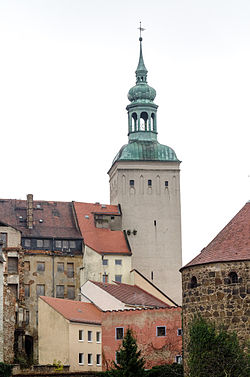Lauenturm
| Lauenturm | |
|---|---|
 Lauenturm |
|
| Data | |
| place | Bautzen , Saxony |
| Construction year | 1400 to 1403 |
| height | 53 m |
| Floor space | 94 m² |
| Coordinates | 51 ° 10 '48.9 " N , 14 ° 25' 24.8" E |
The Lauenturm , in Sorbian , is part of the city fortifications of the city of Bautzen . It is located on the southern edge of the old town , on the western side of the Innere Lauenstrasse , which leads from the Friedensbrücke to the town hall . The tower got its name from the heraldic animal of the Kingdom of Bohemia , a lion (from Leu = lion ). If you left Bautzen in the direction of Bohemia, you had to cross the Lauentor.
history
The Lauenturm was built as a defense tower of the Lauentore at the beginning of the 15th century (1400–1403). This makes it the oldest of the city's gate towers . The stones used for the construction were actually intended by the Bautzen governor for the construction of a Ortenburg tower. Since tensions between town and castle kept coming up, the Bautzen guilds in particular felt threatened by this project. During the absence of the governor, the city council confiscated the stones and the construction of the lauentower began. Later protests of the governor in Prague were able to refute the city with their statement that the construction of the tower would serve the well-being of the city and thus the well-being of the Bohemian crown.
The age of the tower can be recognized, among other things, by its chunky, square shape; later towers were usually rounded in shape so that projectiles could slide off better. The Lauenturm was only accessible from the battlements, the door on the street was built later. Even today there is a connection from the second floor of the adjacent house through the 3 m thick wall to the inside of the tower. In the middle of the 16th century the tower was converted into a maximum security prison. Colloquially this was called "The Prussian". The stone substructure of the tower was crowned by a wooden structure from 1615, which was destroyed in the fire in 1720. The new hood was only completed after 20 years. Between 1615 and 1865, the hour bell in the tower rang as the bell of poor sinners at every execution.
Just like the other gate towers in the city, the Lauenturm was fortified. This formed the southern entrance to the city consisting of four individual gates. In front of it was the city moat, which was initially crossed by a drawbridge and, at the latest, had been a permanent bridge since around 1700. The area at the Lauenturm was particularly well fortified, as the moat began here that surrounded the eastern side of the city up to the student tower. In contrast, the western part of the city was protected by the steep terrain. The interface between the two defense systems was particularly endangered during sieges, which is why the Lauenturm was one of the most important defensive structures.
Between the years 1827 and 1858, the Lauentor was demolished in stages in order to cope with the changed traffic situation in Bautzen. The 6 m high equestrian statue of the Saxon King Albert I attached to the south side was created by Walter Hauschild and unveiled in 1913. At the end of the Second World War , the hood of the Lauenturm was completely destroyed again during the Battle of Bautzen ; it has been reconstructed since 1956. In 1990/91 the tower was extensively restored. Today it can be climbed as a viewing tower as part of guided tours .
legend
In an old Bautzen legend it is said that a long time ago, instead of the Lauengasse, where the Lauenturm stands, there was a wilderness with huge trees and wild animals. There were also lions among the animals. Since lions were also called Leuen at that time, the street was initially called Leuengasse, which later became the current name Lauengasse.
Sources and Notes
- ↑ Sights> Lookout towers> Lauenturm on the website of the city of Bautzen
- ↑ The Lauenburg alley Budissin , Bautzener say, Publisher John Vieweg, Leipzig 24, Page. 3
- ^ Johann Georg Theodor Grasse: The treasure trove of the Kingdom of Saxony , 1855, No. 633 The Lauengasse to Budissin. P. 473; mwN. ( Digitized in the Google book search); Transcription of the version of the second edition on Wikisource.


